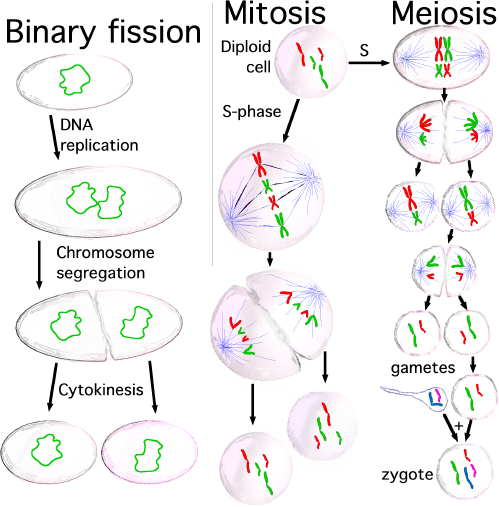
What is the difference between amitosis and mitosis?
Answer
399.9k+ views
Hint: Cells divide so that living things can grow. There are three ways for a cell to divide depending upon its type of cell- Amitosis, Mitosis and Meiosis. As we know mitosis finally results in division of parent alleles, whereas amitosis results in a random distribution of parental alleles. It does not involve the paired structures being pulled in opposite directions by a mitotic spindle in order to form daughter cells.
Complete answer:
Amitosis is also known by the name karyostenosis. It is also called direct cell division or also binary fission. It is basically a cell proliferation that does not occur by mitosis. The mechanism is essential for cell division in prokaryotes.
Whereas mitosis is a part of the cell cycle in which the replicated chromosomes are separated into two new nuclei. The major purpose of mitosis is to replace worn out cells and for growth.
Diagram below shows the difference in steps involved in amitosis or which is also called binary fission and mitosis.

Note:
Mitosis is also known as somatic cell division in which two identical cells are produced. This is because the cell is divided but the number of chromosomes remains the same and mitosis is a continuous process. Various phases like prophase, metaphase, anaphase, telophase, cytokinesis occur in mitosis. Amitosis takes place in a less developed cell of unicellular organisms and ultimately two new cells are formed.
Complete answer:
Amitosis is also known by the name karyostenosis. It is also called direct cell division or also binary fission. It is basically a cell proliferation that does not occur by mitosis. The mechanism is essential for cell division in prokaryotes.
Whereas mitosis is a part of the cell cycle in which the replicated chromosomes are separated into two new nuclei. The major purpose of mitosis is to replace worn out cells and for growth.
| Amitosis | Mitosis |
| Random distribution of parental alleles occurs. | Very precise division of parental alleles takes place. |
| In amitosis the nucleus divides, where each daughter nucleus receives chromosomes but they need not be equally distributed. | Chromosomes are more or less identically duplicated and equally distributed between the daughter cells. |
| Occurs in bacteria, blue-green algae, yeast, amoeba, protozoa. | Occurs in all animal cells, some plants like fungi and some algae. |
Diagram below shows the difference in steps involved in amitosis or which is also called binary fission and mitosis.

Note:
Mitosis is also known as somatic cell division in which two identical cells are produced. This is because the cell is divided but the number of chromosomes remains the same and mitosis is a continuous process. Various phases like prophase, metaphase, anaphase, telophase, cytokinesis occur in mitosis. Amitosis takes place in a less developed cell of unicellular organisms and ultimately two new cells are formed.
Recently Updated Pages
Master Class 11 Accountancy: Engaging Questions & Answers for Success

Glucose when reduced with HI and red Phosphorus gives class 11 chemistry CBSE

The highest possible oxidation states of Uranium and class 11 chemistry CBSE

Find the value of x if the mode of the following data class 11 maths CBSE

Which of the following can be used in the Friedel Crafts class 11 chemistry CBSE

A sphere of mass 40 kg is attracted by a second sphere class 11 physics CBSE

Trending doubts
Define least count of vernier callipers How do you class 11 physics CBSE

The combining capacity of an element is known as i class 11 chemistry CBSE

Proton was discovered by A Thomson B Rutherford C Chadwick class 11 chemistry CBSE

Find the image of the point 38 about the line x+3y class 11 maths CBSE

Can anyone list 10 advantages and disadvantages of friction

Distinguish between Mitosis and Meiosis class 11 biology CBSE




